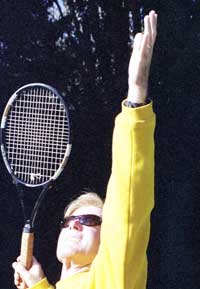To better understand this, set your hand on edge at about
ear level, toss a ball up at least as high as you can fully reach and give
the back of the ball a high five.
If you’re right handed your forearm will rotate from left
to right placing the palm of your hand at the back of the ball (opposite
for a lefty).
Now try holding the racquet at the throat and set it in a
dropped position on edge. Toss a ball up at least as high as the length of
your hitting arm and racquet, swing to it as if giving it a high five and
stop at impact. The racquet face is now flush against the ball. (You will
accomplish the same result if you imagine hitting the upper left hand
corner of the ball).
Next, try holding the racquet normally and do the same
thing until you can consistently hit the ball squarely. Later on you’ll
learn to modify this “square on” contact to produce different spins.
The Follow Through
|

To get the feel for the internal arm rotation, try it holding the
racquet by the throat. |
Now you’re ready for the follow through.
After you strike the ball keep the racquet going up and
out. Your wrist should roll to the outside and the racquet should
decelerate down and past the left leg (right hander).
Don’t make the mistake of stopping the racquet on the
right side or somewhere out in front. These are stunted versions of the
follow through that don’t allow for true completion of the swing.
When you’re comfortable with the movement of the
hitting arm and racquet, it’s time to focus your attention on the
toss and the role of the tossing arm throughout the serve.
|

Don’t make the mistake of stopping after pronation. Your arm should be relaxed and continue all the way across
your body. |
All that work you’ve done on the information above
means nothing if your toss is all over the place!
The Toss
To me, “toss” is a bit of a misnomer because it suggests a
throwing motion. I think of the toss as more of a “lift” in which there’s
a delicate placement of the ball. Prior to releasing the ball it should be
on the pads of your fingers, not the tips and not back in the palm. The
palm should be facing up, the arm extended and lifted by means of the
shoulder.
Make sure the arm drops so that your hand is just
inside the thigh of your front leg, otherwise you won’t get enough
momentum to avoid forcing the toss. The release of the ball should
be as high as you can without tossing it back over your shoulder.
|

Holding the ball on your finger pads at the start of the toss is
crucial. |
I liken this release to the petals of a flower
opening. The fingers should “spread” away from the ball not “snap”
away from it. A great way to practice this is to work at tossing the
ball so it doesn’t spin on the way up.
High-speed video has shown that Sampras is a master of
this and he does it repeatedly during matches! Once you can do this,
notice how quiet and relaxed the lift has become. In the long run it’s
more the idea behind the no- spin toss that will make you a better tosser.
The high, gentle release will lead to a more accurate
placement of the ball on the toss.
|

Lift the ball with your fingers opening like the petals of a
flower. |
A study has shown that the world’s top players generally
toss to a spot somewhere between 8 and 12 inches higher than their point
of contact. The toss needs to be at least as high as the length of your
hitting arm and racquet but that extra height (within reason) allows for
better synchronization of your body to the contact point.
Another way to practice this is to stand at tossing arms
length from the fence and reach up and touch the fence at the length of
your hitting arm and racquet. Now pick a spot about a foot higher and
practice consistently lifting the ball to that spot.
|

The tossing arm moves to extensions after the release and stays
there until the racquet is cocked. |
Your tossing arm should continue upward after the ball is
released so that it’s extended straight up as if pointing at the ball.
A common mistake is to discard the arm the instant the
ball is released. Don’t do this! It tends to speed up the hitting
motion, prematurely open the shoulders and create a jack-knife effect on
the body.
The reality is the arm should remain extended until the
moment the racquet reaches the tip up or cocked position. When the tossing
arm does release it should fold into your mid-section with the elbow bent
at more or less 90 degrees. It can either stay there for the remainder of
the serve, or (more commonly) precede the racquet to the follow through.
Work on these elements individually, then simultaneously,
and get ready for part two!
Your comments are welcome. Let us know what you think
about Scott Murphy's article by
emailing us here at TennisONE.